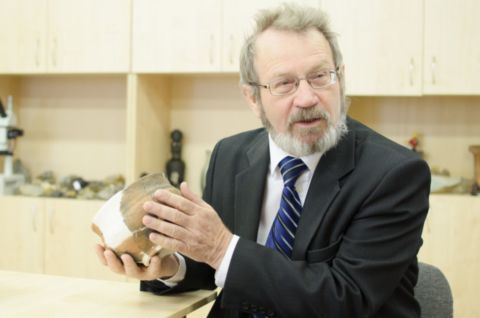The Collaboration of South Ural State University with academic institutions of the Ural Division of the Russian Academy of Sciences has started long before the creation of the Eurasian Studies Research and Education Centre. Prior to that, for quite a very long time, a joint work with the Institute of History and Archaeology of the Ural Division of the Russian Academy of Sciences was conducted on the ethnological, cultural, and economic specifics of the development of the South Ural region. The scientists found out what a huge role pastoral nomadism played on the territory of the South Ural region for the cultural and economic development of the region.
Pastoral nomadism and its role in the development of the region
Director of the Eurasian Studies Research and Education Centre, Doctor of Sciences (History), Professor Aleksandr Tairov; Doctor of Sciences (History), leading Research Fellow of the South Ural Branch of the Institute of History and Archaeology of the Ural Division of the Russian Academy Sergey Botalov; Candidate of Sciences (History) Gayaz Samigulov; Candidate of Sciences (History), Associate Professor Ivan Grudochko; and Kseniia Margarian are successfully conducting the research studies in the field of formation of pastoral nomadism and stages of its development. The scientists are also interested in examining the influence of nomadic society on the natural environment, the interaction of nomads with nature, the relationships of nomadic societies with the outside world, such as the settlements in the forest-steppe zone of the Trans-Ural region and Western Siberia in different periods of history.
One of the major points of interest is the research studies on nomadic societies of the South Ural region. It broadens the knowledge of formation of pastoral nomadism on the territory of South Ural, the Ural-Kazakh steppes, and central Eurasia.
“Pastoral nomadism appeared on the territory of the Ural and Kazakh steppes at the beginning of the first millennium BC. Already in the eighth century BC, nomadic societies could be found there, and they continued to live in those territories until the beginning of the twentieth century. Thus, pastoral nomadism existed on the territory of the Ural-Kazakh steppes for more than three thousand years. This suggests that this form of economy, as well as the semi-nomadic economy in the forest-steppe zone of the Trans-Ural region and Western Siberia, were most adapted to the natural conditions back then. During thousands of years, the nomads elaborated mechanisms that allowed them, in the context of extremely difficult climatic conditions and complex political events, to maintain this form of economy and develop it successfully. In the 19th century, Kazakhstan, annexed to the Russian Empire, supplied a huge number of horses, cattle, sheep, leather, meat, and lard...They supplied mainly livestock products. And by the 19th century pastoral nomadism reached the peak of its development,” says Aleksandr Tairov.
In the 20-30s, the collectivization was implemented in Kazakhstan. Nomads were forced to live and farm at one place. Nomadism was forbidden, and collective farms (kolkhozy) were organised. This led to a gigantic economic failure, and a decrease in the livestock numbers. Many problems arose, and part of the population left Kazakhstan for other regions, in particular, for China. After the 30s there was no such growth of livestock breeding as could be observed in this area in the end of the 19th century. The development of virgin and fallow lands led to the fact that the best pastures that could have been used for livestock breeding were ploughed up, thus causing irreparable damage to cattle rearing in the Ural region and Kazakhstan, from which it never recovered, scientists believe. The works by the historians on the problems of the Bronze Age and the early Iron Age in the South Ural region; on formation of horse utilization in the Ural-Kazakh steppes; on the early middle-ages genetic data from the Ural region; and on certain findings in the collection of the People and Technologies of the Urals Museum at SUSU have already been published.
Research studies are important since many questions arise that can be solved using modern research methods. The use of isotope method, and carbon dating method ‑ research takes on the general trend of the development of archaeological science, which is also changing in the interaction with exact sciences. And the results of the work are quite good, scientists believe.
South Ural State University is a university of digital transformations, where innovative research is conducted in most of the priority fields of development of science and technology. In accordance with the strategies of scientific and technological development of the Russian Federation, the university is focused on elaborating major scientific cross-disciplinary projects.
SUSU is a participant of Project 5-100, aimed at enhancing competitiveness of Russian universities among leading world research and education centres.




